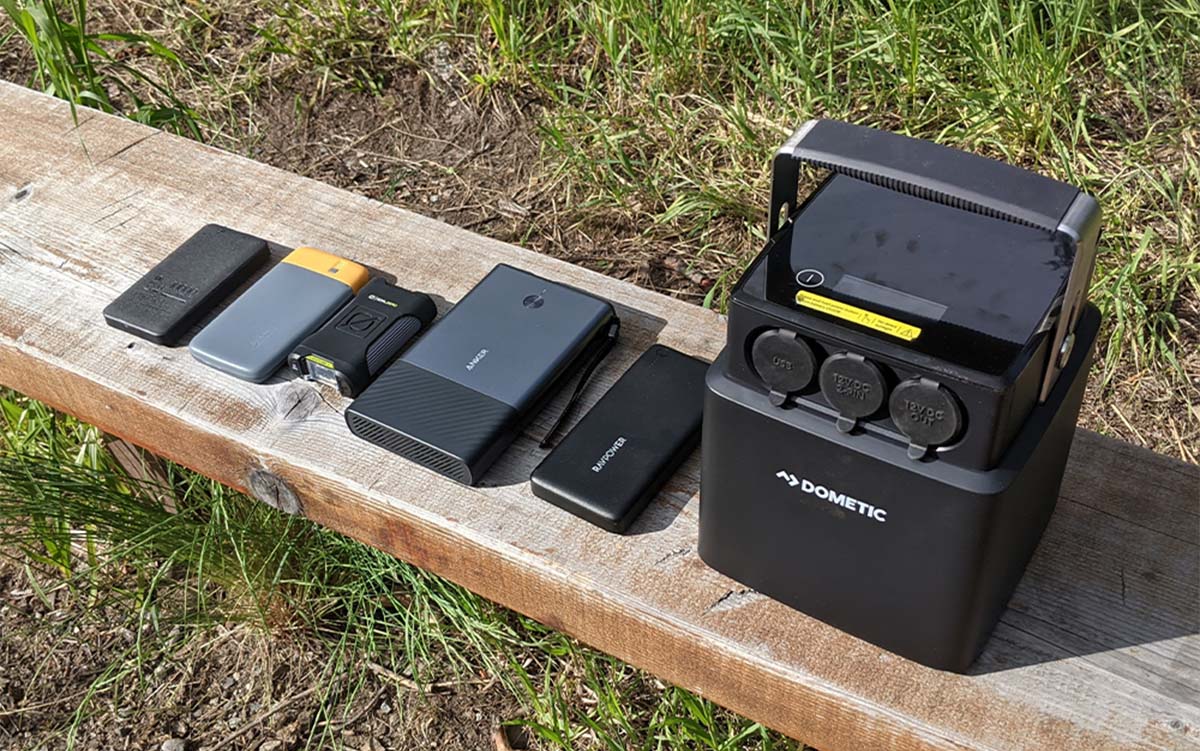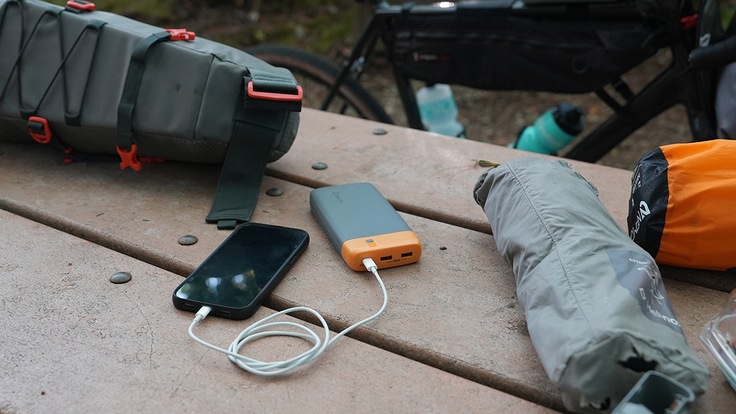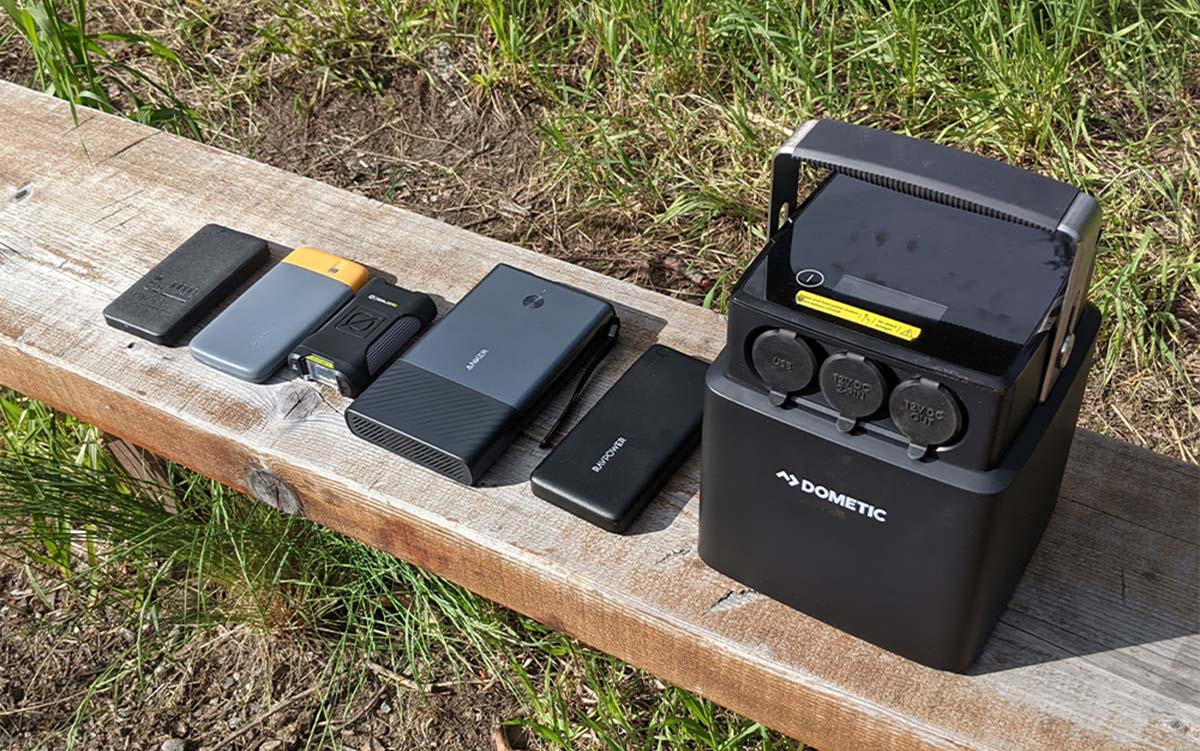Choose a power bank with high capacity (at least 10,000mAh) and multiple USB ports for camping. Ensure it’s durable and water-resistant.
Camping requires reliable power sources for devices. A high-capacity power bank ensures your gadgets stay charged throughout your trip. Look for models with at least 10,000mAh to handle multiple charges for smartphones, tablets, and other devices. Durability is crucial; opt for power banks that are shockproof and water-resistant to withstand outdoor conditions.
Multiple USB ports are useful for charging several devices simultaneously. Lightweight and compact designs are ideal for easy packing and transportation. Solar charging capabilities can be a bonus, providing an eco-friendly way to recharge the power bank during extended stays in nature. Prioritize these features to enhance your camping experience.
Introduction To Portable Power For Camping
Camping is a fun way to connect with nature. But we still need our devices. Phones, cameras, and lights need power. This is where power banks come in. They keep our gadgets running.
The Role Of Power Banks In Modern Camping
Power banks are small and easy to carry. They provide energy for your devices. No need for traditional power sources. Power banks can charge phones, cameras, and even small fans. They make camping more comfortable.
The Shift From Traditional Power Sources To Portable
Old camping gear used batteries or generators. These were heavy and noisy. Power banks are quiet and light. They use USB ports to charge devices. This makes them more eco-friendly.
| Traditional Power Sources | Power Banks |
|---|---|
| Heavy | Lightweight |
| Noisy | Quiet |
| Non-eco-friendly | Eco-friendly |
Choosing the right power bank is key. It should match your camping needs. Look at battery capacity, output ports, and weight. These factors help you make a good choice.
- Battery Capacity: Higher capacity means more charges.
- Output Ports: More ports can charge multiple devices.
- Weight: Lighter power banks are easier to carry.
Power banks have changed the way we camp. They are a must-have for modern adventurers.

Credit: www.outdoorlife.com
Capacity Matters: Sizing Your Power Bank
Choosing the right power bank for camping is crucial. The capacity of the power bank determines how long you can stay connected. Understanding the capacity helps you make the best choice.
Calculating Your Power Needs
First, make a list of your devices. Include your smartphone, tablet, and any other gadgets.
Next, check the battery capacity of each device. You can find this information on the device or its manual.
Here is a simple table to help you calculate:
| Device | Battery Capacity (mAh) | Number of Charges Needed | Total Power Needed (mAh) |
|---|---|---|---|
| Smartphone | 3000 | 2 | 6000 |
| Tablet | 8000 | 1 | 8000 |
Total power needed for this trip: 14,000 mAh.
Why Bigger Isn’t Always Better
A larger power bank has more capacity, but it also weighs more. Carrying a heavy power bank on a hike can be tiring.
Consider the following points:
- Weight and size: A compact power bank is easier to carry.
- Charging speed: Some power banks charge faster than others.
- Number of ports: You might need to charge multiple devices at once.
Choose a power bank that balances capacity with portability. This way, your camping experience remains enjoyable and hassle-free.
Portability And Durability For The Outdoors
Choosing a power bank for camping requires careful consideration. You need a device that is both portable and durable. This ensures your gadgets stay charged in the wild. Let’s dive into the specifics.
Balancing Weight And Power
Weight and power capacity are key factors. A heavy power bank can be cumbersome. Aim for a balance between weight and battery life.
| Weight (grams) | Power Capacity (mAh) |
|---|---|
| 200g | 10,000 mAh |
| 300g | 20,000 mAh |
Lightweight power banks are easy to carry. But they may have lower capacity. Heavier models offer more juice but weigh you down. Choose based on your camping needs.
Rugged Features For Rough Conditions
Your power bank should withstand tough outdoor conditions. Look for features like waterproofing and dust resistance.
- Waterproofing: Keeps your power bank safe in rain.
- Shockproof: Withstands drops and impacts.
- Dust resistance: Prevents damage from dirt and debris.
Rugged designs often include protective casings. Ensure your power bank has a solid build. This ensures it lasts through multiple trips.

Credit: www.rei.com
Power Output: Matching Your Devices
Choosing a power bank for camping requires careful consideration of power output. Understanding the specific needs of your devices ensures they stay charged. This section will guide you on matching the power output of a power bank with your devices.
Understanding Amperage And Voltage Requirements
Every device has unique amperage and voltage requirements. Smartphones, for instance, typically require 5V and 1A to 2A. Tablets and larger devices may need more power, often around 5V and 2A to 3A. Check your device’s manual to find these requirements.
Matching these requirements ensures safe and efficient charging. Overloading a device with too much power can damage it. Underpowering may result in slow charging or no charging at all.
| Device Type | Voltage (V) | Amperage (A) |
|---|---|---|
| Smartphone | 5V | 1A – 2A |
| Tablet | 5V | 2A – 3A |
| Laptop | 19V | 3A – 5A |
Multiple Ports For Simultaneous Charging
Camping often involves multiple devices. Look for power banks with multiple ports. This feature allows charging several devices at once.
- USB-A ports: Common for most devices.
- USB-C ports: Ideal for newer gadgets and faster charging.
- DC output: Useful for larger devices like laptops.
Ensure each port provides the correct voltage and amperage for your devices. Some power banks offer smart charging technology, which adjusts output based on the device connected.
This feature protects your devices and ensures they charge efficiently. It also means less hassle during your camping trip.
Battery Type And Efficiency
Choosing the right power bank for camping is crucial. Understanding the battery type and efficiency can help you make an informed decision. Different battery types offer various benefits and drawbacks. Efficiency impacts how well your power bank charges and manages heat.
Lithium-ion Vs. Lithium-polymer
Power banks generally use Lithium-ion or Lithium-polymer batteries. Knowing their differences helps you pick the best one.
| Feature | Lithium-ion | Lithium-polymer |
|---|---|---|
| Energy Density | Higher | Moderate |
| Weight | Lighter | Slightly Heavier |
| Cost | Less Expensive | More Expensive |
| Durability | Good | Better |
Lithium-ion batteries are lighter and less expensive. They have a higher energy density, offering more power. Lithium-polymer batteries are more durable and safer. They are also flexible in shape, though slightly more expensive.
Charging Efficiency And Heat Management
Charging efficiency matters when selecting a power bank for camping. Efficient charging ensures your devices get powered up quickly.
- High Charging Efficiency: Look for power banks with at least 80% efficiency.
- Heat Management: Choose power banks with good heat dissipation.
Heat management is critical for safety and performance. Power banks with poor heat management can overheat. This can cause damage or reduce battery life. Opt for models with built-in protection features.
Some power banks come with smart charging technology. This adjusts the output to match your device’s needs. It helps in preventing overheating and overcharging.
Solar Charging: Harnessing Natural Energy
Choosing a power bank for camping involves considering solar charging options. Solar power is a great way to harness natural energy. It ensures your devices stay charged while enjoying nature. Let’s explore the benefits and features of solar charging for power banks.
Integrated Solar Panels Vs. Standalone Units
Power banks come with two types of solar charging options: integrated solar panels and standalone units.
Integrated solar panels are built directly into the power bank. This option is convenient and portable. It means you only need to carry one device. Integrated solar panels are great for short trips and light use.
Standalone units are separate solar panels that you connect to your power bank. They usually offer more power and faster charging. Standalone units are ideal for longer trips and heavy use. They allow you to place the panels in the sun while keeping the power bank in the shade.
Realistic Expectations From Solar Charging
It is important to have realistic expectations from solar charging. Solar panels work best in direct sunlight. Cloudy days or shade can slow down the charging process.
Here are some tips to maximize solar charging efficiency:
- Place the solar panels in direct sunlight.
- Avoid obstructions like trees or tents.
- Angle the panels towards the sun.
- Use a larger solar panel for faster charging.
Solar charging is slower than plugging into an outlet. It is a great backup solution while camping. Always start with a fully charged power bank. This ensures you have enough power when you need it.
| Feature | Integrated Solar Panels | Standalone Units |
|---|---|---|
| Portability | High | Moderate |
| Charging Speed | Slow | Faster |
| Convenience | Very Convenient | Less Convenient |
Extra Features For Enhanced Camping Experience
Choosing the right power bank for camping goes beyond just battery capacity. Extra features can significantly enhance your camping experience. These features can offer convenience, safety, and better device management.
Built-in Flashlights And Emergency Features
Many power banks come with built-in flashlights. These can be very handy during camping. A built-in flashlight means one less item to pack. Some power banks also include SOS lights for emergencies.
Emergency features like solar charging panels can be lifesavers. They allow you to recharge your power bank using sunlight. This is particularly useful when you are off-grid for extended periods.
Some advanced models even come with weather-resistant designs. This ensures that your power bank is safe from rain or dust. Look for power banks with rugged designs for outdoor activities.
Smart Power Banks With Device Management
Smart power banks can manage multiple devices efficiently. They come with multiple USB ports, allowing you to charge several devices at once.
Some smart power banks feature automatic device recognition. This optimizes the charging speed for each device. This feature can save you time and ensure your devices are charged safely.
Another useful feature is pass-through charging. This allows the power bank to charge itself and other devices simultaneously. This is very convenient during camping when power sources are limited.
Table of Features:
| Feature | Benefit |
|---|---|
| Built-in Flashlights | Provides light and saves packing space |
| SOS Lights | Useful for emergency situations |
| Solar Charging Panels | Allows recharging using sunlight |
| Weather-Resistant Designs | Keeps power bank safe from elements |
| Multiple USB Ports | Charges multiple devices simultaneously |
| Automatic Device Recognition | Optimizes charging speed for each device |
| Pass-Through Charging | Charges power bank and devices at the same time |
Choosing a power bank with these extra features can make your camping trip more enjoyable and hassle-free. Ensure you select one that meets your specific needs and preferences.

Credit: www.outdoorlife.com
Brand And Price: Finding Value For Money
Choosing a power bank for camping can be tricky. You want something reliable, but you also don’t want to spend too much. Finding the right balance between brand and price is crucial.
Trusted Brands In Portable Power
Picking a power bank from a trusted brand gives peace of mind. Here are some well-known brands:
- Anker: Known for quality and durability.
- RAVPower: Offers good value for money.
- Goal Zero: Popular for outdoor use.
- Jackery: Reliable and efficient.
These brands have good reviews and are popular among campers.
Budgeting For Quality And Reliability
Quality and reliability should not be compromised. It’s important to budget wisely. Here’s a simple table to help you out:
| Price Range | Features | Best For |
|---|---|---|
| $20 – $50 | Basic, small capacity | Short trips, emergencies |
| $50 – $100 | Medium capacity, more ports | Weekend camping, multiple devices |
| $100+ | High capacity, solar charging | Long trips, heavy usage |
Set a budget based on your needs. A higher price often means better quality. But don’t overspend if you don’t need extra features.
Remember, it’s about finding the right balance. Choose a trusted brand and stick to your budget. This way, you get the best value for your money.
User Reviews And Field Tests
Choosing a power bank for camping can be tricky. User reviews and field tests help make an informed decision. They provide real-world insights and experiences that can guide your purchase.
Learning From The Experiences Of Others
Reading user reviews can save you time and money. Many users share their experiences online. They talk about the battery life, durability, and performance of power banks.
Look for reviews that mention camping specifically. These will be more relevant to your needs. You can find reviews on:
- Amazon
- Outdoor gear websites
Pay attention to both positive and negative reviews. This will give you a balanced view of the product.
The Importance Of Real-world Testing
Field tests show how a power bank performs in real conditions. Lab tests are useful, but real-world tests are better. They show how the power bank works in different weather and terrains.
Look for field tests conducted by outdoor enthusiasts. They often test the power bank’s:
- Charging speed
- Battery capacity
- Durability
These tests can be found in blog posts, YouTube videos, and outdoor forums.
Field tests help you see the true performance of a power bank. They reveal any weaknesses that lab tests might miss. This information is crucial for camping trips where reliability is key.
Safety Precautions And Maintenance
Choosing a power bank for camping needs careful attention to safety and maintenance. A well-maintained power bank ensures reliable performance and longevity. Here, we will cover essential safety precautions and maintenance tips.
Protecting Your Power Bank From The Elements
Keep your power bank dry and away from water sources. Use a waterproof case to shield it from rain and spills. Avoid exposure to extreme temperatures. High heat can damage the battery, while cold can reduce its efficiency. Store it in a cool, dry place when not in use.
Long-term Storage And Care Tips
Charge your power bank to about 50% before storing it. This helps maintain battery health during long-term storage. Avoid storing it in very hot or cold environments. Regularly check and charge the power bank every three months to ensure it remains functional.
| Action | Frequency |
|---|---|
| Charge to 50% | Before long-term storage |
| Avoid extreme temperatures | Always |
| Check and recharge | Every 3 months |
Conclusion: Making The Informed Choice
Choosing the right power bank for camping can be tricky. This guide helps you make the best choice. Camping is fun, but you need power. A good power bank ensures you stay connected. Here is a recap of the key considerations and final thoughts.
Recap Of Key Considerations
Before buying a power bank for camping, consider these key factors:
- Battery Capacity: Aim for a power bank with at least 20,000mAh. This ensures multiple charges for your devices.
- Weight and Size: Choose a compact and lightweight model. This makes it easier to carry during hikes.
- Durability: Look for a rugged design. Waterproof and shockproof features are essential.
- Charging Speed: Check for fast charging capabilities. A good power bank should have at least 2.1A output.
- Number of Ports: More ports allow you to charge multiple devices. Aim for at least two USB ports.
- Price: Balance quality with cost. Don’t compromise on essential features.
Final Thoughts On Selecting Your Camping Power Bank
After considering the key factors, you can make an informed choice. A good power bank is crucial for your camping trip. It ensures your devices stay powered. This helps you stay safe and enjoy your adventure.
Remember to check for additional features. Some power banks have built-in flashlights. Others may offer solar charging options. These features can be very useful during camping.
To make it easier, here is a quick comparison table:
| Feature | Recommendation |
|---|---|
| Battery Capacity | At least 20,000mAh |
| Weight and Size | Compact and Lightweight |
| Durability | Waterproof and Shockproof |
| Charging Speed | Fast Charging (2.1A or more) |
| Number of Ports | At least 2 USB Ports |
| Price | Balance Quality and Cost |
Use this guide to choose the perfect power bank. Happy camping!
Frequently Asked Questions
What Size Power Bank Do I Need For Camping?
For camping, choose a power bank with at least 10,000mAh. This size can charge a smartphone 2-3 times.
How Do I Choose A Portable Power Station For Camping?
Choose a portable power station by considering battery capacity, weight, port options, and recharging methods. Check reviews and budget.
How Do I Know What Power Bank I Need?
To choose the right power bank, check your device’s battery capacity. Select a power bank with higher mAh. Ensure it has multiple ports if needed. Consider the size and weight for portability. Read reviews for reliability.
What Is The Difference Between A Power Bank And A Portable Power Station?
A power bank charges small devices like phones. A portable power station powers larger electronics and appliances, offering more capacity.
Conclusion
Choosing the right power bank for camping ensures your devices stay charged. Consider capacity, weight, and durability. Look for features like fast charging and multiple ports. A reliable power bank enhances your camping experience, keeping you connected and safe. Happy camping with a fully charged power bank!




